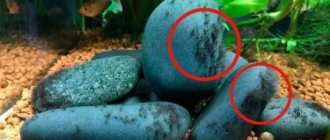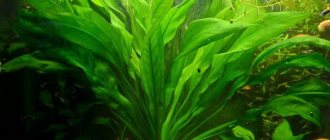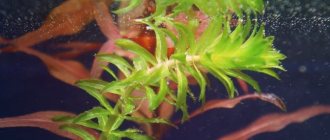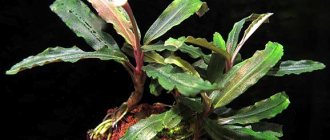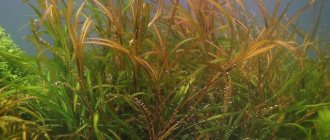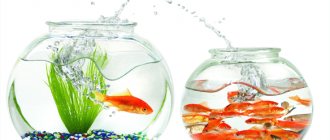When decorating an aquarium, we use various decorative elements. For ease of maintenance, you can use artificial driftwood, plants, and stones. But in order for the inhabitants of the aquarium to feel comfortable in their home, it is better to use natural decorative elements, this will allow you to recreate conditions as close as possible to natural ones. To do this, you can plant living plants in the shrimp tank, place driftwood and stones there, but when decorating the aquarium, special attention should be paid to such natural products as Indian almond and oak leaves, as well as alder cones.
Leaves and cones will not only serve as a wonderful decoration for your shrimp tank, but will also bring a lot of benefits to its inhabitants. They perfectly form the natural habitat of crustaceans, create favorable soil for the development of algae, which shrimps love to feast on, and they will also serve as a place for shelter and growth of crustacean fry.
Almond tree leaves for aquarium
Under natural conditions, crustaceans live among decaying foliage and feed on it; this is from their native biotope. Therefore, it is better if there is foliage in the aquarium. For this you can use the leaves of alder, maple, hazel, willow and naturally oak and almond. Almond tree leaves are an excellent preventative against many crustacean diseases. They have disinfectant properties and kill most bacteria and fungi in water. They strengthen the immunity of the inhabitants of the aquarium and stimulate their digestive system. Depending on the amount of foliage used, the water turns yellowish, this is due to humic acids.
Under no circumstances should you use well-dried almond leaves, as they contain toxic substances. Before putting them in the aquarium, the leaves need to be doused with boiling water and dried well until they turn brown. After that, two or three leaves per hundred liters of aquarium water are enough.
When the leaves are saturated with water and sink to the bottom, the shrimp, and especially the young ones, eat everything in five to ten days, since almonds are an excellent substrate for single-celled shrimp. After which you can add new leaves.
Natural Aquarium Medicine
Return to section: Aquarium care
Some aquarists first encountered alder cones in practice after receiving an order from an online store selling shrimp. The companies sending the order add alder cones to containers with shrimp to prevent spoilage and contamination of the water, to increase the immunity of the shrimp during shipment. Those who use alder cones in their home aquariums say that shrimp even love to sit on them. What is so useful about these buds?
Alder cones
Alder cones and bark contain a lot of tannins, which have an anti-inflammatory, disinfecting, and microflora-restoring effect. Placed in an aquarium, alder cones slightly lower the pH of the water and are effective in combating bacteria and fungi. Alder cones also color the water, but this creates the appearance of a natural biotope. And besides, they look natural and serve as a refuge for shrimp and small snails. In addition, due to its properties, alder wood lasts for a long time under water, so cones or sticks from alder bark submerged in water can remain in an aquarium for up to 3-4 months without losing their beneficial properties.
The dosage depends on the condition of the cones: cones freshly picked in the fall (after the first frost) are more effective (they also color the water more strongly) than cones collected after prolonged rains or from the ground. On average, add about 5 to 10 cones per 100 liters directly to the aquarium, first they float for a while (several minutes) and then sink; It is not recommended to use pre-brewed buds, because... in this case, their effect is reduced. The buds can remain in the aquarium until they are eaten by catfish or rot, up to several weeks/months.
Alder grows along rivers and streams throughout Central Europe, with black alder being the most common. Cones can be collected all year round, the only important thing is that you cannot use green cones, only brown ones. In the fall, you need to wait for the first frosts, when the fresh cones lose their seeds, and there will be no problems with alder germinating in aquariums.
Now many companies offer to purchase alder sticks, and where possible, aquarists can collect alder cones or twigs themselves. Before immersing them in the aquarium, they should be doused with boiling water and soaked in water for several hours. In Old Russia, at the dawn of aquarium farming, our ancestors, knowing the valuable properties of alder, used cones to start an aquarium.
Cinnamon
Cinnamon bark has similar properties. Cinnamon sticks immersed in an aquarium give the water a slightly reddish color and serve not only as shelter for invertebrates, but also as a source of fibrous food. The bark of the cinnamon is soft, and the shrimp and crayfish bite it off little by little. Cinnamon releases all its beneficial substances into the water faster than alder. After 3-4 weeks, you should put a fresh batch of sticks into the aquarium, and leave the old ones to rot; they will be eaten by the invertebrate inhabitants of the aquarium. Dosage - per 100 l, place 1-2 cinnamon sticks (from a diet store) in an aquarium for 1 week, then remove!
Or as a decoction, pour 1 cinnamon stick (not powder) with 1 liter of boiling water (do not boil), close and leave for 10 minutes, then pour into an airtight container. Sick fish are placed in a small fish tank (10-20 liters) or in a bucket (or something similar), ensuring good aeration. and add cinnamon decoction drop by drop (can be added through a thin hose). The fish is closely monitored at all times, and if it begins to sway, the procedure is stopped immediately. If the fish tolerates the procedure calmly, then it is left in the medicinal solution for 10 minutes and then returned to the aquarium. After this, the fish can be further treated by placing a cinnamon stick in the aquarium.
Oak leaves
Fallen leaves are collected in the fall. You can often find such leaves in the spring, but they are colonized by fungi, bacteria, etc., and are second-rate. To get rid of fungi and bacteria, the leaves must be doused with boiling water before adding them to the aquarium. Such a scarce commodity as oak leaves serves not only as a disinfectant due to the abundance of tannins in them, but also as an excellent food for shrimp. Oak leaves scalded with boiling water and placed in an aquarium completely decompose within a few weeks, serving all this time as food for invertebrates. Fortunately, in the cities of Russia and Ukraine you can easily find oak wood. But, for example, in Germany, dried oak leaves are sold at a price of 2 euros for 35 leaves. Dosage: depending on who you like, only sometimes when laying foliage in a thick layer on the bottom (several centimeters), a lack of oxygen in the water may occur due to increased metabolism by bacteria in the aquarium. The introduced fresh leaves initially float and, only after a few days, sink. To speed up the process, you can pour boiling water over the leaves before placing them in the aquarium. The leaves are destroyed in about 2-6 weeks (depending on the pH value - the softer and more acidic the water, the longer the decomposition takes) or are eaten even earlier.
Indian almond leaves
The leaves of the Indian almond tree have bactericidal and fungicidal (antifungal) properties and slightly acidify the water. Before placing them in the aquarium, they must be doused with boiling water. Leaves placed in an aquarium release organic acids into the water, such as humic acids and tannic acids. They can be useful in inhibiting many types of bacteria, as well as neutralizing harmful heavy metals found in the aquarium, giving the water a slight amber color. Almond leaves decompose in about 5-10 days, after which new leaves must be added, and these decomposing ones will be eaten by shrimp and crayfish.
Oak leaves in a shrimp tank
Oak leaves also have excellent disinfectant properties and, during the decomposition process, are used as food by shrimp. Before putting them in the shrimp tank, the leaves need to be doused with boiling water. They are also an excellent natural acidifier and can turn water brownish.
Finding oak leaves is not difficult to find, the main thing is not to collect leaves that:
➤ grew up in polluted areas, along roads;
➤ treated with chemicals;
➤ you need to choose only healthy, undeformed and undamaged leaves;
➤ You cannot take leaves that have been lying on the ground for a long time; it is better to choose recently fallen ones, after which they must be laid out to dry as quickly as possible.
Herbal medicine in the aquarium - plants that everyone knows
Tekhi
- Yur, everyone knows that you can use Indian almond leaves in an aquarium, many know about oak leaves and bark, alder cones. Some even use tea. Are there any other plants that are medicinal and useful for the aquarium? After all, herbal medicine occupies an important place in human medicine, right?
Yu.V.
- Certainly! The use of chemicals to treat fish and improve the condition of plants and the aquarium as a whole is not always justified, because any chemical has a significant effect on the fish’s body, weakening their immunity. Many hydrobionts, such as mollusks, crayfish, crabs, shrimp and aquarium plants, do not tolerate “chemical attack” at all. At the same time, “branded” drugs are usually not cheap in relation to the price of fish. The use of natural herbal remedies in aquarium farming solves all these problems, and not only in treatment, but also in improving the food supply based on the use of dry and artificial food. Herbal supplements are a natural source of microelements and minerals, proteins and fats of plant origin, amino acids, and vitamins. With the correct and competent use of this wealth, success is guaranteed.
Tekhi
- Will you tell me?
Yu.V.
- Let me better ask my friend Mikhail Gusev, who is well known to you, to tell him. He has a very good article in the magazine “Wildlife” about the use of various herbs, leaves, cones in aquarium farming. Should he have told?
Tekhi
- Certainly! With pleasure! By the way, isn’t it him you invited today?
Yu.V.
- His. )) As I knew. And here he is.
Mikhail Gusev
- Hi guys! I think I'm on time?
Tekhi
- Yes, Misha, we can’t wait to hear about your article on herbal medicine.
Mikhail Gusev
- Well, the article is not entirely mine, I once found it on the website pokormiribok.com. It belongs to an author unknown to me with the nickname igor17. But this doesn’t change the essence, I’ll be happy to tell you. ))
I want to say right away that herbal medicine in an aquarium can also have unpleasant consequences if we overdose on our drugs. Therefore, after reading that article, through trial and error, I came to some of my own conclusions. I decided not to use some plants, and changed the dosages in some. Mostly downwards.
Tekhi
- Will you share?
Mikhail Gusev
- Certainly.
First about the treatment?
Yu.V.
- Let's. ))
Mikhail Gusev
- Let's go. By default, I will talk about dosages for a 100-liter aquarium. I would like to make a reservation right away: in most cases, it is better to use autumn leaves that are well-ripened, have just begun to turn yellow, but have not yet fallen. Where it is better to take spring ones, I will talk separately.
1. Leaves of maple, poplar, willow
They can be used without special restrictions, but within reasonable limits. Pour boiling water over, cool. They have weak bactericidal properties.
Tekhi
— Like melafix?
Mikhail Gusev
- Something like that. Promote the emergence and development of microorganisms responsible for biobalance in aqua. Can be an alternative to soil in shrimp tanks, replacing the substrate every 5 - 6 weeks. They serve as shelter with a rich assortment of nutrition (macro and microelements, amino acids, minerals, fiber, etc.). Color the water in the aquarium light yellow. Actually, until this color is reached, add the decoction. Participate in stabilizing pH and KH values. On a 100-liter aquarium you can put 2 - 3 maple or 5 - 6 birch or willow.
2. Hazelnut leaves
4 – 5 leaves need to be doused with boiling water. Well, put it in the aquarium. They have antibacterial properties. In addition, they improve the general condition of aquatic organisms. Lower the KH and pH slightly. Replace leaves every 4 to 6 weeks.
3. Oak and beech leaves
5 – 8 leaves need to be doused with boiling water before being sent to the aquarium. For the prevention of various diseases. But they have rather little effect against fungal and bacterial infections. They still slightly lower the pH and KH, but color the water a little more strongly than maple, willow and poplar. The greatest preventive effect will be when used simultaneously with alder cones.
4. Alder cones
Tekhi
- Oh, I know, this is a very effective remedy!
Yu.V.
- In general, yes, but not a panacea...
Mikhail Gusev
- Agree.
4 – 5 cones need to be doused with boiling water and placed in the aquarium. For the prevention of diseases (bactericidal and fungicidal) or fungal infections (as an addition to treatment). Slightly lowers pH (at low pH to a greater extent).
5. Walnut leaves
Pour boiling water over 1 – 2 leaves (its leaves have 7 – 9 leaflets on the petiole). This is for prevention. For treatment - 3 - 5. Help with all types of damage, fungal infections. They have bactericidal properties and are used by some species of fish (catfish) as additional feeding.
6. Birch leaves
If for a fish tank, then up to 20 leaves, if in a general aquarium, then 8 – 12 leaves. Pour boiling water over it and place it in the aquarium. They have a beneficial effect in the treatment of ulcers and tumors. They are used for treatment in detention centers for a week or more; long periods of time until complete recovery are possible. Almost the only leaves that are best used are the spring harvest (May - June).
7. Tea leaves (leaf, not flavored) Green tea - 3 tablespoons. Black tea - 2 tablespoons.
Pour boiling water twice for 3 – 5 minutes and drain. You can only use the third pour of boiling water with a volume of 1 liter. After cooling, pour small portions of 50 - 100 ml into the aquarium, observing the fish. The color of the water in the aquarium should be light straw. Enriches aquarium water with vitamins, microelements, polyphenols and tannins. Prevention and treatment of diseases and fungal infections by prolonged exposure to the above elements and substances on the skin and mucous membrane affected by parasites and fungal formations. Treatment may last several weeks until complete recovery, with partial water changes weekly and restoration of the original concentration of the drug. Treatment with tea is carried out in emergency cases, in cases of clearly expressed symptoms of the disease and the absence of specialized drugs.
Tekhi
- And Yura said that you can brew a strong brew of black tea and give it to the aquarium until it turns a light straw color. Lied, right, Mish?
Mikhail Gusev
- I wasn’t completely lying. It is rather a general tonic. And I’m talking about the medicinal properties of tea.
8. Cinnamon sticks
It is antibacterial and fungicidal (against fungal diseases). It should be used primarily for ulcers, suppuration and problems with the mucous membrane.
Treatment in a community aquarium: 1 stick is placed in the aquarium for 1 week, then be sure to REMOVE!
In a 20 liter fish tank: 1 stick is poured with boiling water (200 ml) and then added drop by drop to a container with sick fish and observed: as soon as it starts to sway, immediately stop the procedure. If everything is normal, 10 minutes. exposure and then further treatment in a general aquarium according to the first recipe.
Yu.V.
- It’s somehow harsh... It’s probably out of despair...
Mikhail Gusev
- Well, yes, something like that.
Tekhi
— And I would also add that the drug is not cheap at all. And you need to buy carefully, there are a lot of counterfeits on the market.
Mikhail Gusev
— I agree completely, Ir.
9. Horse chestnut, leaves
It has pronounced anti-inflammatory properties, stimulates blood circulation, promotes wound healing, and has an analgesic effect.
Infuse five grams of dry leaves in 200 ml of hot water in a water bath for 30 minutes, cool, and filter. It is good to use it in combination with other herbal remedies.
10. Pine nuts
Yu.V.
- Shouldn’t you give pine nuts to the fish? Expensive!
Mikhail Gusev
- Well, two dozen pine nuts won’t make you poor. )) But look how useful it is.
Of the nitrogenous substances, proteins predominate, which in turn are characterized by a high content of amino acids, and arginine predominates among them: it promotes metabolism, body growth and restoration of biological tissues. Carriers of vitamins A, B, E, PP: vitamin A and vitamin B complex have a beneficial effect on the growth and development of juvenile aquatic organisms; Vitamins of group E are very important and indispensable for ensuring full heredity. Indispensable in preparing breeders for spawning, in spawning tanks and nursery aquariums. A large set of minerals, macro- and microelements, including: zinc - plays a significant role in tissue restoration, iodine - necessary for full metabolic processes, has bactericidal properties, promotes wound healing, calcium, phosphorus - for the restoration of musculoskeletal tissues and etc. They contain amino acids necessary for full development, and also contain biologically active substances. Nut shells contain tannins, amino acids, microelements, and have a beneficial effect on the skin and mucous membrane.
Tekhi
- Impressive!
M.G. A decoction of nuts has an astringent, analgesic and anti-inflammatory effect, strengthens the immune system, and helps eliminate harmful substances.
15 – 20 unshelled nuts, ground in a coffee grinder and poured with 200 ml of hot water, heat in a water bath for 30 minutes, let sit with the lid closed for at least 2-3 hours, filter.
11. Wormwood, leaf collection
But I would still recommend buying it at the pharmacy, because preparing it requires certain skills.
It has pronounced anti-inflammatory properties.
Brew 1.5 tablespoons (7 - 8 g) per 200 ml of hot water in a water bath for 15 - 20 minutes, cool, strain.
Treatment in a septic tank, exposure from 15 minutes to 1 hour. Add the medicinal decoction in small portions of 15 - 20 ml. The course of treatment is 7–10 days with a mandatory break of 2–3 days. Then, if necessary, the course of treatment can be repeated. At the end of the course of treatment (possibly during it), take baths with herbal preparations with general strengthening (restoration and maintenance of immunity) and nutritional (microelements and vitamins) effects.
12. And here is another very interesting herbal medicine. Pomegranate peel (with added seeds, without pulp)
Strengthens the immune system. A good antiseptic. Has an anti-inflammatory effect. A good restorative remedy after infectious diseases.
Contains 15 amino acids, vitamins P, C, B6, B12, iodine, potassium, silicon, iron, calcium, tannins. 2 tbsp. spoons of dried peels and grains crushed in a coffee grinder, pour 200 ml of hot water, bring to a boil, leave with the lid closed for 2 hours, cool, filter, pour in portions. Treatment is carried out in a septic tank (10 - 15 l), exposure from 20 minutes to one and a half hours. To improve the nutritional properties of the medicinal decoction, it is recommended to add freshly squeezed pomegranate juice diluted with water in a 1:3 ratio (juice/water) to the aquarium. Pour in small portions of 10 - 20 ml. Just in case, it makes sense to monitor the well-being of the fish.
13. And, of course, plantain, where would we be without it!
It has anti-inflammatory properties, promotes the healing of wounds and ulcers.
Contains: carotene, vitamins C and K, tannins, enzymes. It can be used either independently or in combination with other herbal remedies.
2 tbsp. Steam tablespoons of crushed dry plantain leaves in 200 ml of hot water in a water bath for 30 minutes, cool, strain. Well, to the aquarium. ))
Yu.V.
“I couldn’t even imagine that so many different plants could be used in aquarium keeping!”
Mikhail Gusev
- Oh, that's not all! I'm only talking about the most effective ones. Now, perhaps, I’ll tell you about one more blade of grass and then we’ll move on to the second group of useful plants.
Tekhi
- Come on, Misha, very interesting!
Mikhail Gusev
- Of course, you also know this plant well.
14. Red clover (flowers, leaves, root)
Flowers, leaves: pour one and a half tablespoons into 200 ml of hot water in a water bath for 20 minutes, cool, filter. Also, of course, dry crushed. The root will be more serious. The root contains an antifungal substance, trifolyrizin. It has antimicrobial, anti-inflammatory, antitumor and astringent properties.
Chopped root: 2 tbsp. spoons, pour 200 ml of hot water in a water bath for 30 minutes, leave for 2 hours, filter. The composition includes simple and complex carbohydrates, vegetable proteins and fats, vitamins C, K, E, B, carotene, minerals and trace elements magnesium, copper, calcium, chromium, iron, phosphorus), alkaloids, tannins. It can be used either in combination with other herbal remedies or separately.
Well, let's move on to plants - nutritional supplements?
Yu.V.
- Certainly. Very interesting!
Mikhail Gusev
— Here, many plants are repeated with medicinal ones, so I won’t show those photos that I showed earlier, okay?
Tekhi
- Certainly. ))
Mikhail Gusev
- So.
1. Stinging nettle
Leaves and young shoots are used, previously dried and crushed in a coffee grinder to the consistency of flour. Contains carotene, various acids, vitamins C, K, A, B1, B2, microelements: iron, copper, manganese, chromium, etc. Strengthens metabolic processes, strengthens the immune system.
2. Calendula officinalis or marigold
We use flowers, dried and crushed in a coffee grinder to the consistency of flour. Contains carotenoids, essential oils, organic acids and other useful components. Recommended as a herbal supplement to enhance the color of fish in red tones.
3. Carrots
The root vegetable is finely chopped, well dried and ground in a coffee grinder to the consistency of flour. Contains vitamins B, PP, C, E, K, carotene, proteins (1.3%), carbohydrates (7%), microelements: potassium, iron, phosphorus, magnesium, cobalt, copper, iodine, zinc, chromium, nickel , fluorine Saturation of the organism of hydrobionts with microelements and vitamins, natural enhancement of the integumentary color (red and yellow tones).
4. Garden lily (tiger) red-orange with black spots
Dried petals, ground to a flour consistency. Contains a set of vitamins, microelements, carbohydrates, carotene, fiber, etc. It is used as a phyto-supplement to enhance the natural color of fish.
5. Red clover A collection of leaves and flowers, dried and ground to the consistency of flour. Vegetable proteins and fats, vitamins C, K, E, group B, carotene, minerals, trace elements, alkaloids. Improves the general condition of the fish, strengthens the immune system and the natural integumentary coloration of the body in red and yellow tones.
6. Dandelion flowers
Collected at the initial stage of flowering, dried and ground to a consistency, flour is added to the feed. A lot of calcium, rich in antioxidants, contains carotenoids and other beneficial substances, components and vitamins. Helps strengthen the skeleton of fish, enhances metabolic processes, and has a general strengthening effect. It is also used as a natural color enhancer for fish.
7. Hazelnuts (hazelnuts)
Grind the kernels in a coffee grinder to a creamy paste. After this you can add it to the food. Rich in vitamins and a large set of microelements, vegetable proteins and fats. Maintains high vitality and strengthens the immune system.
8. Walnut
Grind the kernels in a coffee grinder to a cream paste and add to the food. Rich in microelements, vitamins and minerals. Contains essential oils and active biological additives, vegetable proteins and fats. Helps strengthen the immune system, tissue growth and overall development of aquatic organisms.
9. Pine nuts Grind the peeled kernels in a coffee grinder to a cream paste. And also for food. Natural bank of vitamins and microelements. Contains vegetable proteins and fats. Promote metabolism and rapid growth of the body.
10. Leaves of oak, maple, hazelnut and walnut, Indian almond tree
Here's an almond leaf
Whole ones are doused with boiling water and placed in an aquarium. Rich in vitamins and microelements, fiber. Directly used as feed additives for certain species of fish and crustaceans.
Tekhi
- Wow! Just know that you can feed fish and shrimp with all this!
Yu.V.
- Not only is it possible, but it is also necessary.
Mikhail Gusev
— Once again I want to emphasize that all leaves, flowers, roots, etc. first you need to dry it - I gave all weight calculations for dry leaves.
Yu.V.
— Thank you, Mish, very much for such a meaningful and interesting conversation.
Tekhi
- And thanks from me! I learned so many new things!
Mikhail Gusev
- You're welcome. It was very nice to chat. )))
Share link:
Similar
Alder cones in a shrimp tank
Another excellent way to decorate and improve the quality of aquarium water are alder cones. Alder contains quite a lot of tannins, which have anti-inflammatory and disinfecting effects, so they are an excellent preventive measure against bacterial and fungal infections. Also, alder cones, due to the presence of humic acid, are used to acidify aquarium water.
Alder cones can be used in an aquarium with fish. But they are especially relevant in shrimp tanks, since preparations containing copper cannot be used in an aquarium with crustaceans. And thanks to their unique properties, they have a positive effect on water quality and improve the health of the aquarium inhabitants. In addition, the tannins of the cones improve the condition of the shell of crustaceans.
online now
Please tell me if there is any experience of their positive use as a water acidifier in a decorative aquarium. In the old literature, it is almost mandatory to use it mainly in the breeding of characins. In the forums there are completely opposite opinions: from “great for health, appearance, and for stabilizing water” to “terribly harmful, because... kills all microflora incl. useful."
I threw both alder cones and oak ladders, although 3-4 pieces per 300 liters catfish munch on them
Are the leaves fresh, or fallen, or dried?
I threw both alder cones and oak ladders, although 3-4 pieces per 300 liters catfish munch on them
and how does it feel? Have you measured the water parameters?
It seems to me that it’s better to try dripping orthophosphoric acid. And you will need a lot of alder cones!
It is useless as an acidifier. I highly recommend using it as a supplier of tannins to aquarium water. Tannins (tannins) have antimicrobial and antifungal properties, as a result of which they are even used in human medicine for an anti-inflammatory effect. I keep caecilians that absolutely do not tolerate chemical drugs, so for prevention, once or twice a month I brew alder fruit from the pharmacy, cool it and pour it into the aquarium.
Please tell me if there is any experience of their positive use as a water acidifier in a decorative aquarium. In the old literature, it is almost mandatory to use it mainly in the breeding of characins. In the forums there are completely opposite opinions: from “great for health, appearance, and for stabilizing water” to “terribly harmful, because... kills all microflora incl. useful."
Everything grows and lives in Mytishchi water. from characins to Malawians and all kinds of plants. for breeding characins - yes.
Therefore, for prevention, once or twice a month I brew alder fruit from the pharmacy, cool it and pour it into the aquarium.
I used to constantly use alder, but then I switched to Tetra Thorumin. In my opinion, it has exactly the same effect on the aquarium.
Therefore, for prevention, once or twice a month I brew alder fruit from the pharmacy, cool it and pour it into the aquarium.
I used to constantly use alder, but then I switched to Tetra Thorumin. In my opinion, it has exactly the same effect on the aquarium.
207




